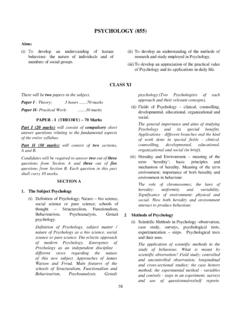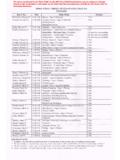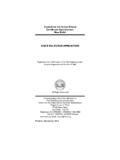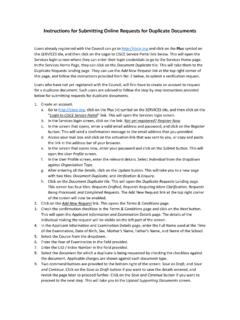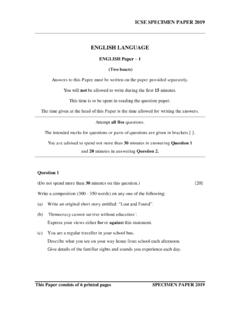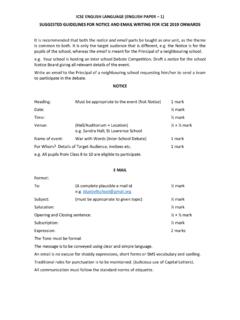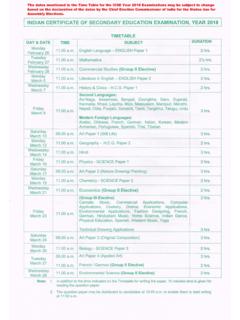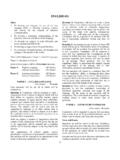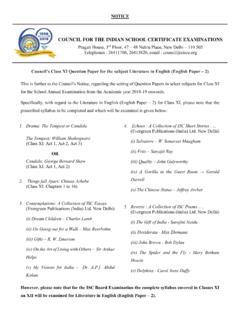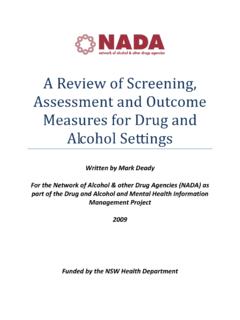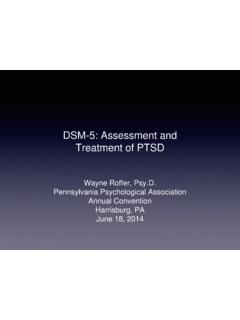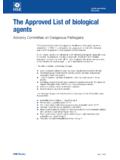Transcription of PSYCHOLOGY
1 PSYCHOLOGY (855). CLASS XII. There will be two papers in the subject: 2. Personality Paper I - Theory: 3 hours 70 marks (i) What is meant by Personality. Paper II- Practical Work: 30 marks Definition of personality Allport. (ii) Theories of Personality: Type Theories, PAPER - I (THEORY) 70 Marks Psychoanalytic Theory - Freud's structure Part I (20 marks) will consist of compulsory short of personality; psycho-sexual stages of answer questions relating to the fundamental development; Post Freudians (in brief);. aspects of the entire syllabus. Humanistic - Rogers and Maslow; Traits - Allport, Cattell; Social/Behavioural Part II (50 marks) will consist of two sections, Learning Bandura. A and B. Candidates will be required to answer two out of Type Theory: Sheldon, Hippocrates, Psychoanalytic Theory of Personality: three questions from Section A and three out of five Freud's levels of consciousness, structure of questions from Section B.
2 Each question in this part personality - Id, Ego and Superego;. shall carry 10 marks. principles on which they function;. Psychosexual stages of development and SECTION A fixation; Post Freudians: Erik Erikson, 1. Intelligence and Ability Horney; Humanistic theories of Rogers (concept of fully functioning persons) and (i) Intelligence: what is meant by intelligence - Maslow (self actualization). Traits: Allport theories regarding the nature of (central, secondary and cardinal traits), intelligence; how intelligence is measured - Cattell (source and surface traits). The five- the concept of IQ, intelligence tests factor model of Costa and McCrae. Social Individual Tests, Group Tests. Levels of Cognition Theory of Bandura (explanation intelligence and associated characteristics. of concepts). Emotional Intelligence (EQ).
3 (iii) How personality is assessed: reports, Intelligence: definition of intelligence inventories (MMPI), projective techniques - (David Wechsler); what is meant by Thematic Apperception Test, Behavioural intelligence - theories regarding the nature Analysis. of intelligence; Theories of Intelligence: Two Factor Theory Charles Spearman; The use of Self Reports - inventories/. Primary Mental Abilities Thurstone; questionnaires in assessing Personality - an Raymond Cattell Fluid and Crystallised understanding of the MMPI (Minnesota Intelligence. Modern Theories: Information Multiphasic Personality Inventory); what is Processing; Triarchic Theory Sternberg; meant by Projective Techniques - how the Theory of Multiple Intelligence Howard TAT (Thematic Apperception Test) is used Gardner. How intelligence is measured - (Test details should include procedure, the concept of IQ; Intelligence Tests scoring and results).
4 Individual Test - Wechsler (WAIS-3), Group Behavioural Analysis: interview , Test Raven's Progressive Matrices. Test Observation, Nomination, Behavioural details (Aim, history, description, scoring ratings, Situational tests. and uses) should be included; Levels of intelligence and associated characteristics (from gifted to below average). Emotional SECTION B. Intelligence (EQ) - Characteristics of 3. Lifespan Development Emotionally Intelligent Persons. (i) Meaning of Development, growth and (ii) Aptitude, Achievement and Interest: maturation. meaning of these terms. Reason for their Meaning of development, growth and assessment and means of assessment maturation; Why is the study of lifespan (different tools/ tests) used. development important? What is meant by Aptitude - when aptitude needs to be assessed - the GATB (General (ii) Infancy - Cognitive development, socio- Aptitude Test Battery); meaning and emotional development.
5 Usefulness of Achievement tests; Why Cognitive development Piaget's Sensory Interest is measured. Motor Stage; socio-emotional development 1. emergence of attachment. Mary 5. Psychological Disorders and Psychotherapy Ainsworth's & Lamb's strange situation test. (i) Meaning of Abnormal behaviour - biological, psychological and socio - (iii) Childhood - Cognitive development, Moral cultural perspectives. Principles of development. classification of psychological disorders Cognitive development Piaget's Theory with reference to DSM IV. (Preoperational and Concrete). Moral Common features of abnormal behaviour- development Kohlberg's perspective deviance, distress, dysfunction, danger. Experiment on Moral Dilemma pre- Different views of "abnormal" behaviour - conventional, conventional and post the statistical stand - the biological/medical conventional morality.
6 Approach - the psychodynamic perspective - (iv) Adolescence - Cognitive development; the sociocultural dimension; why some major concerns. classification of disorders is necessary - an Cognitive development Piaget's Formal understanding of the Diagnostic and Operational Stage; some major concerns Statistical Manual of Mental Disorders IV. delinquency, substance abuse (drugs and (brief explanation of each Axis). alcohol) meaning of substance abuse, (ii) Characteristics of some psychological, symptoms; eating disorders - bulimia, behavioural and developmental disorders: anorexia. Anxiety - generalised, phobic, obsessive- compulsive; Mood - bi-polar, depression 4. Stress and Stress Management (causes and symptoms of all). (i) Meaning of stress - its basic nature. What is meant by anxiety - different forms Strain and Eustress; Stress as a process - of anxiety disorders: phobias, obsession - stressors (negative and positive events); the compulsive disorders; Mood disorders- stages of GAS or the General Adaptation characteristics of severe depression, manic- Syndrome (Selye's model).
7 Cognitive depressive or bipolar disorder (causes and appraisal of stress primary and symptoms). secondary. Behavioural and Developmental Disorders- (ii) Common causes of stress. Attention Deficit Hyperactive Disorder External/situational: major life events, (ADHD), Autism. minor hassles of everyday life, work-related (iii) Schizophrenia - meaning; main types;. causes, the physical environment. characteristics. Internal/dispositional: Personality Basic nature of Schizophrenia - variables-traits and types. characteristics of Disorganized Catatonic (iii) Effects of stress on health. and Paranoid Schizophrenia (symptoms). Upsets the internal mechanism and effects (iv) Psychotherapy - Psychoanalysis; Client- balance - immune system, hypertension, centred; Behavioural. heart problems, ulcers, diabetes, asthma What is meant by Psychotherapy - central (each effect to be briefly explained).
8 Features of psychodynamic therapies - free (iv) Stress management - ineffective and association, dream analysis, transference effective strategies of handling stress. and counter transference; the principles on Coping with stress: Ineffective strategies - which client centred therapy has been defence mechanisms - rationalization, developed. Behavioural therapies based on projection, reaction formation, regression, classical and operant conditioning and repression, displacement, sublimation (each modelling. to be briefly explained); Effective strategies - relaxation training and yoga. 6. Social Thought and Social Behaviour Promoting positive health and well-being: (i) Social bias Exercise, Diet, Self-Care, Life Skills;. Positive thinking and attitude. Biases in forming judgements (attribution). Explanation with examples each of the following biases- the self-serving bias, the false consensus effect, automatic vigilance.
9 2. (ii) Social Influence- how people try to change (III) Method - (i) Sample of the Study others' behaviour; social norms; conformity (ii) Procedure followed (data- and obedience - factors affecting them. collection, nature of raw data). Meaning and characteristics of a group; (iii) Statistical Treatment of Data types of groups. What is meant by social (iv) Results & Discussion norms - why people conform to social (v) Conclusion norms and why they digress; factors affecting Conformity and Obedience. Asch's The practical work will be assessed by the study on conformity; why and when people teacher and a Visiting Examiner appointed obey others - Milgram's experiment. locally and approved by the Council. 7. Attitudes Mark allocation per study [15 marks]: (i) Meaning of Attitude - how attitudes are Basic Concept 3 marks formed and changed.
10 Method (correctness of procedure) 4 marks What are attitudes - the components of Results and discussion 4 marks attitude; the process of forming attitudes - Viva 4 marks how attitudes change: persuasion. (ii) Prejudice meaning of prejudice and A. Statistics discrimination; the origins of prejudice; To study group differences in Examination results. how to combat prejudice. Groups: Any two classes or two sections of the An understanding of the meaning of same class with same subjects. prejudice and how it works in the form of discrimination - causes of prejudice: social Raw Data: Summated scores on all subjects in the learning, realistic competition, social annual examination for each student. categorization and stereotyping; ways in Analysis: which prejudice can be resisted. (i) Group analysis Calculate mean scores (central 8.)
